


(Posted on 07/06/24)
The handling of dry bulk materials used to be a completely manual process, but it is now being increasingly automated in a drive to reduce both the costs and the risks of injury, while also increasing throughput and accuracy.
The demands of today’s highly competitive commerce and modern industry are such that speed, accuracy and efficiency are required within every process. This includes the handling of dry bulk materials, such as grain, coal, aggregates, minerals and chemicals through every stage of their logistical journey from producer through processor and distributor to eventual end-user.
Not surprisingly, major handling facilities are now highly computerised, and often have a control room with a bank of computers, which would not look out of place on the USS Enterprise. Their job can be summed up as collecting information from many, many different sources, collating it, and then calculating the optimum procedures for every stage of the overall process.
The computers represent a well-developed technology and their data processing abilities, while hugely impressive, are based on relatively simple logic algorithms. The technology developments that are driving the advancement of bulk handling are at the sensing end of the system, where the prevailing conditions of the moment are detected and converted into data signals for the computer to use.
"Sensors are the eyes and ears of the computerised system,” says Mark Ingham of Sensor Technology Ltd, one of the companies at the forefront of developments. “They constantly monitor what is going on and feed real-time data to the computer."
One of their latest products is a load sensor with a difference. Called LoadSense, it is wireless, so is ultra easy to deploy in situations like docks and grain banks where installing cables would be difficult – and maintaining them even harder!
LoadSense is online permanently and constantly sends real-time load value signals to either the central computer or its own local computer or receiver for preliminary analysis. It can be used in all types of materials handling operations, but is particularly useful for measuring loads in augers and on conveyors, where materials are ‘in flight’, so the load varies constantly with time.
LoadSense can be thought of as a two-part system. First, is a strain gauge-based stainless steel tension type sensor, with a twin antenna transmitter built into it for transferring the load data the instance it is generated. The second part of LoadSense is the receiver, which can be either fixed in place or handheld. The receiver reads, displays and records the data and can pass it onto the central control system for integration with other data streams for analysis.
The receiver includes an in-built 32MBit memory, which can hold up to 280 hours of data, thus providing both a local control station and a backup databank for the wider system. It is also notable that each receiver can collect data from several nearby load sensors simultaneously, in a range of up to 100m.
Leading vessel performance platform Smart Ship Hub says the industry should expect a breakthrough year... Read more
The Nordic countries are taking an important step towards decarbonising maritime transport with the... Read more
Germany’s Steelpaint has appointed ADD Marine as its representative for Greece and Cyprus, strengthening... Read more
Rio Tinto’s first Pilbara-made iron ore rail car has rolled off the production line in Karratha... Read more
Precision meets progress at Phu My Port, Vietnam. The LPS 550 has been deployed to handle bulk commodities... Read more
bound4blue, a global leader in wind propulsion systems, has expanded its industrial footprint in Asia... Read more
As the industry explores multiple decarbonisation pathways, methanol is gaining attention as a practical... Read more
Technology group Wärtsilä will supply an integrated hybrid propulsion system for a bulk carrier... Read more
Superior Industries, Inc., a US-based manufacturer and global supplier of bulk material processing and... Read more
ESL Shipping has taken a significant step forward in digitalisation by deploying a new multichannel... Read more